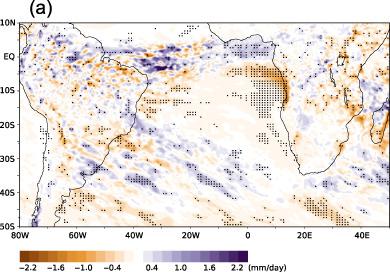当前位置:
X-MOL 学术
›
Int. J. Climatol.
›
论文详情
Our official English website, www.x-mol.net, welcomes your feedback! (Note: you will need to create a separate account there.)
Regional atmospheric response to the Benguela Niñas
International Journal of Climatology ( IF 3.9 ) Pub Date : 2020-08-03 , DOI: 10.1002/joc.6782 Shunya Koseki 1, 2 , Rodrigue Anicet Imbol Koungue 3
International Journal of Climatology ( IF 3.9 ) Pub Date : 2020-08-03 , DOI: 10.1002/joc.6782 Shunya Koseki 1, 2 , Rodrigue Anicet Imbol Koungue 3
Affiliation

|
We investigate how the atmosphere is affected by the cold sea surface temperature (SST) anomalies of the Benguela Niñas using reanalysis data and a high‐resolution atmospheric model. A composite analysis of reanalysis data based on five Benguela Niña events (5 years out of 39 years for 1979–2017) reveals that the rainfall along the Angolan coast is reduced significantly and other anomalies of precipitation are detected over the African continent and equatorial Atlantic. Those anomalies can be explained by the anomalies of vertically‐integrated moisture flux (VIMF) and its divergence and convergence. Additionally, the Namibian low‐level cloud and sea level pressure (SLP) are enhanced around the ABFZ by the Benguela Niñas. A simulation of the model forced by the cold SST anomalies of the Benguela Niñas reproduces the reduction (enhancement) of rainfall and VIMF divergent (convergent) anomaly over the Angolan coastal region (Gulf of Guinea). However, the other anomalies over the African continent are not significant. It is suggested that the effects of the Benguela Niñas are limited along southwestern coast of Africa. Composite analysis of reanalyses of rainfall anomalies associated with Benguela Niña events shows pattern over the other regions which might be induced by larger‐scale atmospheric anomaly. This large‐scale atmospheric anomaly can be linked with the South Atlantic Anticyclone and/or forced by the teleconnection from the tropical Pacific, for instance. The increment of the Namibian low‐level cloud and SLP is simulated by the numerical experiments consistently. The low‐level cloud becomes more frequent between 950 and 900 hPa and the radiative cooling by longwave radiation is reinforced during the Benguela Niñas events. In contrast, the cloud formation around 850 hPa is reduced and radiative cooling is weakened. It is indicated that this change in the cooling rate possibly induces the strengthening in the inversion layer over the cold SST anomalies.
中文翻译:

对BenguelaNiñas的区域大气响应
我们使用重新分析数据和高分辨率大气模型研究了大气如何受到本格拉·尼尼亚斯海域冷海表面温度(SST)异常的影响。根据五个本格拉·尼尼亚事件(1979-2017年,39年中的5年)对再分析数据进行的综合分析显示,安哥拉沿岸的降水量大大减少,在非洲大陆和赤道大西洋上也发现了其他降水异常。这些异常可以用垂直积分水分通量(VIMF)的异常及其发散和收敛来解释。此外,本格拉·尼亚尼斯(BenguelaNiñas)增强了ABFZ周围纳米比亚的低层云和海平面压力(SLP)。由BenguelaNiñas的冷SST异常强迫模型的模拟再现了安哥拉沿海地区(几内亚湾)降雨和VIMF发散(收敛)异常的减少(增强)。但是,非洲大陆上的其他异常现象并不明显。建议在非洲西南海岸沿途,本格拉·尼尼亚斯的影响是有限的。对与BenguelaNiña事件有关的降雨异常重新分析的综合分析表明,其他地区的模式可能是由更大范围的大气异常引起的。例如,这种大规模的大气异常可能与南大西洋反气旋有关,和/或受到了来自热带太平洋的遥相关的强迫。通过数值实验一致地模拟了纳米比亚低层云和SLP的增量。在BenguelaNiñas事件期间,低层云在950和900 hPa之间变得更加频繁,并且长波辐射的辐射冷却得到加强。相反,在850 hPa附近的云形成减少,辐射冷却减弱。结果表明,冷却速率的这种变化可能会导致冷SST异常上反演层的强化。
更新日期:2020-08-03
中文翻译:

对BenguelaNiñas的区域大气响应
我们使用重新分析数据和高分辨率大气模型研究了大气如何受到本格拉·尼尼亚斯海域冷海表面温度(SST)异常的影响。根据五个本格拉·尼尼亚事件(1979-2017年,39年中的5年)对再分析数据进行的综合分析显示,安哥拉沿岸的降水量大大减少,在非洲大陆和赤道大西洋上也发现了其他降水异常。这些异常可以用垂直积分水分通量(VIMF)的异常及其发散和收敛来解释。此外,本格拉·尼亚尼斯(BenguelaNiñas)增强了ABFZ周围纳米比亚的低层云和海平面压力(SLP)。由BenguelaNiñas的冷SST异常强迫模型的模拟再现了安哥拉沿海地区(几内亚湾)降雨和VIMF发散(收敛)异常的减少(增强)。但是,非洲大陆上的其他异常现象并不明显。建议在非洲西南海岸沿途,本格拉·尼尼亚斯的影响是有限的。对与BenguelaNiña事件有关的降雨异常重新分析的综合分析表明,其他地区的模式可能是由更大范围的大气异常引起的。例如,这种大规模的大气异常可能与南大西洋反气旋有关,和/或受到了来自热带太平洋的遥相关的强迫。通过数值实验一致地模拟了纳米比亚低层云和SLP的增量。在BenguelaNiñas事件期间,低层云在950和900 hPa之间变得更加频繁,并且长波辐射的辐射冷却得到加强。相反,在850 hPa附近的云形成减少,辐射冷却减弱。结果表明,冷却速率的这种变化可能会导致冷SST异常上反演层的强化。



























 京公网安备 11010802027423号
京公网安备 11010802027423号